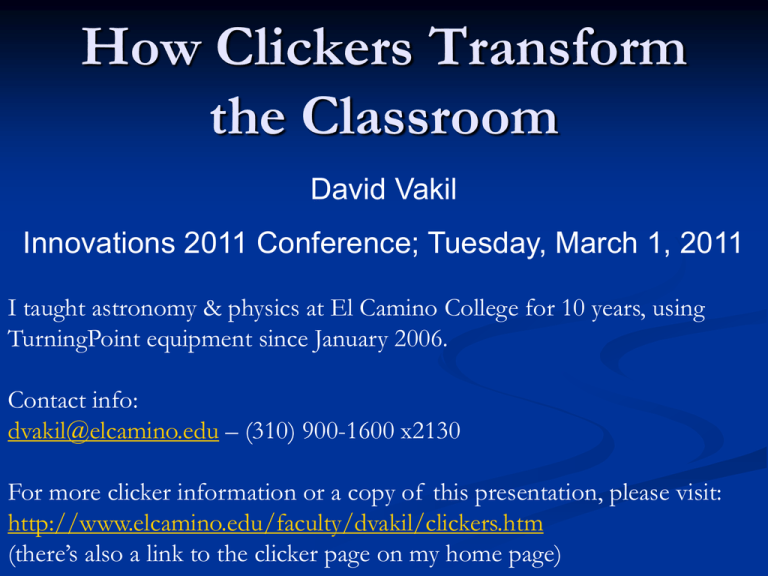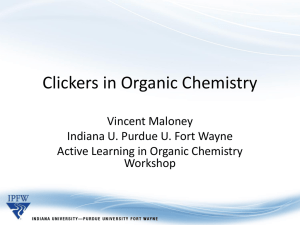How Clickers Transform the Classroom David Vakil
advertisement

How Clickers Transform the Classroom David Vakil Innovations 2011 Conference; Tuesday, March 1, 2011 I taught astronomy & physics at El Camino College for 10 years, using TurningPoint equipment since January 2006. Contact info: dvakil@elcamino.edu – (310) 900-1600 x2130 For more clicker information or a copy of this presentation, please visit: http://www.elcamino.edu/faculty/dvakil/clickers.htm (there’s also a link to the clicker page on my home page) Presentation outline How can clickers be used? Discuss your concerns and questions about clicker usage Types of clicker questions Write your own questions Working together to improve your questions Big Picture: Clickers enable you to do student-centered learning. Let’s start with a “student”-centered activity, rather than with me lecturing. This is what clickers are about. Respond as though you are students in YOUR class. By show of hands… Who believes: “Not enough students answer questions that I ask during class.” Blank Slide Not enough students answer questions that I ask during class. 0 1. 0 2. True False See how much the vote participation increases with clickers? What are your concerns, questions Work in a group Write 3-5 questions you have about clickers Biggest concerns Unanswered questions We will discuss your questions and concerns. Other uses for clickers Taking attendance (automatic if any question is asked) Classroom demographics Who are your students? How does performance relate to various characteristics? Assessing student work during class See Chronicle article Ice-breakers Discussion starters Tests Ranking Choices (i.e. students put a list in order) Cheating How might students cheat? What should we do about it? These ideas are discussed in Doug Duncan’s book: Clickers in the Classroom Treat clicker usage like any other assignment Specifically mention code of conduct, expectations, penalties Grading, Quizzes, and Tests Grading Do NOT use clickers only as a means to “grade” students. They dislike that and strongly prefer formative assessment. Research by Wiloughby and Gustafson (Mont. State U) shows if grading responses, low-stakes (i.e. points for voting) produces more learning and richer discussion than high-stakes (i.e. points/extra points for correct answer) Quizzes and Tests NXT clickers can handle tests & quizzes Requires some student training of the clickers, so I won’t demonstrate that now. Qualitative reasons to use clickers Interactive Student-centered, minds-on Just-in-time teaching Immediate feedback – to you AND your students Research (John Barnett): what students value most. Create responsible & informed learners! FUN (competitive?) Gets everyone actively (not passively) involved (Semi?) anonymous, which helps shy students! Early and frequent assessment. Diagnose and fix bad lectures/activities Catch poor students quickly, start troubleshooting early Some examples of how clickers can be used to immediately assess learning PRE-TEST: A light year is a measure of 0 1. 0 2. Time Distance Timed question! 15 Checking current understanding during class A miniature astronomy lecture The universe is 13.7 billion years old. A light year is ____________________________, approximately 6 trillion ______________. POST-TEST: A light year is a measure of 0 1. 0 2. Time Distance POST-TEST: A light year is a measure of 50 Time 50 50 Distance 50 First Slide Second Slide Think-Pair-Share Ask the question If results are between 50-75% correct, consult with your neighbor and vote again. If 40% correct, coach them a little first. If less than 40% correct, they need more help first. Usually results improve noticeably, often 80+%. Students understand and remember concept better Takes only 3 minutes or less Here’s an example… It is possible for astronomers to detect an object 15 billion light years away from Earth. 0 ls e 0 Fa 2. True False Tr ue 1. Other question types Question types: One right answer (like mine, so far) Questions with no correct answer (anonymous?) Have you ever used illegal drugs? Which political party do you identify with most? Questions with more than one right answer. Putting a list in order (rank, prioritize) From Chronicle article: Evaluate your classmate’s work using these criteria … Demonstration/video: Predict what happens next Write your own clicker questions Work in a small group, write 3-5 questions. Suggested question style: Write an important question about a lesson you are teaching or taught very recently. Write a SHORT one or two line correct answer Write 3-4 common INCORRECT answers, approximately the same length as the correct answer. Bring your question and answers to me. Don’t tell me which is correct. We will insert new slides into this PowerPoint… CONCLUSION There are a LOT of things you can do with clickers in your class Method of student-centered metacognitive learning (students love immediate feedback!) They dramatically increase learning with good questions. Particularly well-suited for lecture classes STRONGLY RECOMMEND READING: Derek Bruff’s book Teaching with Classroom Response Systems, Creating Active Learning Environments.

